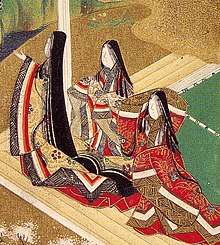Haori
The haori (羽織) is a traditional Japanese hip- or thigh-length jacket worn over a kimono.
_MET_DP330781.jpg)
The haori resembles a short, typically waist- or mid-thigh-length kimono, but differs slightly in its construction, as it has no overlapping front panels (known as the okumi) allowing it to wrap over the body. The haori is typically sewn with a thinner collar than is seen on a kimono, and features two thin, triangular panels at each side seam, a feature also not seen on a kimono. The haori is typically tied at the front with two short cords, known as the haori himo, which attach to small loops sewn into the internal collar seam.
During the Sengoku period, sleeveless haori were worn over armour, much like the tabard was in Europe. During the Edo period, economic growth allowed the socially-low but economically-wealthy merchant classes the ability to buy haori, which – following the introduction of laws forbidding grand displays of wealth amongst the lower classes – gave rise to the creation of haori with sombre external appearances and lavishly-decorated linings,[1] a trend still visible on men's haori today.
During the early 1800s, the geisha of the Tokyo hanamachi of Fukagawa began to wear haori over their kimono in an effort to appear iki - stylish in a casual, subdued manner. Before this time, haori had only been worn by men, making the style unusual and fashionable. By the 1930s, women wearing haori had become commonplace, and geisha dropped the practice.[2]
See also
| Wikimedia Commons has media related to Haori. |
- Hanten, a less formal jacket; the worker's version of the more formal haori; as winterwear, it is often padded for warmth, as opposed to the somewhat lighter happi.
- Happi, a lighter version of a hanten, traditionally worn by shop keepers, sometimes uniform between the helpers of a shop (not unlike a propaganda kimono, but for advertising business), and is now associated mostly with festivals.
- Hifu, protective padded outer vest or pinafore, worn by young children over their kimono on outings, such as Shichi-Go-San.
- Michiyuki, a traditional Japanese double-breasted overcoat, characterised by a signature square neckline (for showing off the multiple collars of the kimono worn beneath) and dual fastenings.
References
- More Japanese Haori Jackets & How To Tie A Haori Himo
- Dalby, Liza (2000). Geisha (3rd ed.). London: Vintage Random House. pp. 277, 333. ISBN 0 09 928638 6.
